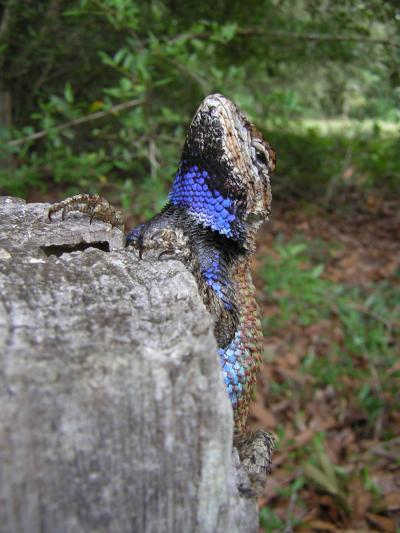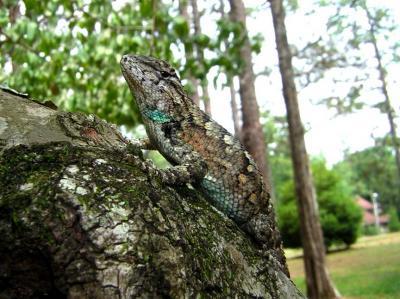Which do male lizards find sexiest, the more feminine kind or the masculine?
Researchers recently tackled this question by examining the mating behavior and blue-color patterns of fence lizards in Arkansas, Alabama, and Mississippi and offer some insight into the evolution of male-female differences.
Male Sceloporus undulatus fence lizards have bright blue "badges" outlined in black on both sides of their throats and abdomens, and previous studies have shown that testosterone drives the production of these badges, which are highly visible during the animal's courtship rituals and other behavioral displays.
Many females also have this blue ornamentation, less vibrant and that covers a smaller area, and they are more numerous than those without.

Male fence lizard with male-type bright blue "badges" outlined in black. Mating-behavior studies of lizards in three southern US states have revealed which females male lizards find to be the sexiest. The research provides insight into the evolution of male-female differences. Credit: Langkilde lab, Penn State University
Penn State University biology associate professor Tracy Langkilde and graduate student Lindsey Swierk designed experiments to determine whether male lizards preferred the more-masculine bearded ladies or their more-feminine sisters. "We found that, although males do not say 'no' to bearded ladies, they clearly discriminate against blue-ornamented females, opting more often to court females without coloring," Swierk said. "The question is 'why'? Is it possible the males mistake the bearded ladies for fellow males? Or are bearded ladies somehow less fit and, therefore, less attractive to males?"
To answer this last question, the team members studied the differences between the reproductive output of bearded ladies and the less-common females without male-pattern coloring. They found that, compared to their more-feminine counterparts, bearded ladies laid clutches that weighed less. In addition, they laid their eggs about 13 days later in the mating season.
"The lower mass may indicate that the eggs have smaller yolks and so the embryos don't have as many available nutrients," Langkilde said. "As for the timing, the 13-day difference is significant. It means that the bearded ladies' offspring hatch later, so they have less time to gather food and to prepare for overwinter hibernation, which is a tough period that few babies survive. As a result, females with less blue coloration may have an evolutionary advantage with regard to the fitness of their offspring. This might explain why males tend to prefer them."
Langkilde and Swierk hypothesize that, although bearded ladies currently are more common in many fence-lizard populations, the evolutionary tide might be turning. "What we might be observing is a gradual trend toward more sexual dimorphism within this species," Swierk said.
Sexual dimorphism is defined as the difference in color, shape, size, or structure between males and females of the same species. For example, human males tend to be larger than human females and they also have other distinguishing characteristics such as stronger brow ridges and more facial and body hair. Darwin and others have suggested that one of the major factors driving these differences is sexual selection -- the theory that an animal chooses a member of the opposite sex based on some observable feature that signals good health and superior genes.
Although the classic example of this phenomenon involves selection of males by females -- namely, the male peacock's elaborate and calorically expensive tail attracting the female peahen -- sexual selection likely also explains why males are more attracted to females with certain "fitness-signaling" traits.
"It is possible that, over the course of several generations, we will see the more-feminine lizards winning out over their bearded-lady sisters," Langkilde added. "In time, the percentage of bearded ladies could dwindle and the balance could shift. However, another possibility is that bearded ladies have some other evolutionary advantage that keeps their numbers high within populations."

A female "bearded-lady" fence lizard with blue coloration. Bearded ladies are generally much more common than their counterparts with little or no blue ornamentation, but appear to incur greater fitness costs. Mating-behavior studies of lizards in three southern US states have revealed which females male lizards find to be the sexiest. The research provides insight into the evolution of male-female differences. Credit: Langkilde lab, Penn State University
That other evolutionary advantage, the team members explained, could be behavioral. For example, bearded ladies, which likely have higher levels of testosterone, might be more aggressive and thus better able to fight off predators or competitors when compared to the more-feminine females.
"Bearded ladies also may be more sexually aggressive so, although the males don't prefer them, they may initiate more of the courtship and mating and produce as many or more offspring for this reason," Langkilde said. "Another possibility," she added, "is that bearded ladies may benefit by having especially sexy sons."
The team's previous research has shown that females prefer really blue males and so, "if these bearded ladies pass their vivid coloration on to their sons, this could give them an advantage by ensuring they have lots of grandchildren," Langkilde said.





Comments